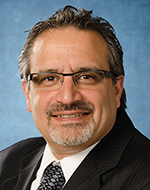Page Content
More Than a Union
Teacher Welfare contributes to world-class education system
 I often say, “I am a proud Alberta teacher!” Just like my colleagues throughout the province, I am a professional. I am a life-long learner, I reflect on my practice, I read and I am actively involved in my professional organization. These are the tenets that define a professional.
I often say, “I am a proud Alberta teacher!” Just like my colleagues throughout the province, I am a professional. I am a life-long learner, I reflect on my practice, I read and I am actively involved in my professional organization. These are the tenets that define a professional.
The structure of the Alberta Teachers’ Association offers its members opportunities to participate in a variety of ways through its different program areas: Government, Member Services, Professional Development and, yes, Teacher Welfare (TW). While Teacher Welfare is a small draw on the overall budget, there are times when its union work (i.e. negotiations) takes centre stage.
Teacher Welfare’s core work includes attaining collective agreements that outline teacher salaries, benefits and conditions of practice. Negotiations are often considered the “union” at work. I do represent Alberta teachers during times of negotiation and will not deny the ATA’s union function.
It is important for teachers, parents and the public to understand the true value of this work. Attracting young professionals to our teaching compliment is paramount. Salary and benefits serve some of this purpose. If Alberta school boards are not competitive, our talent will leave the province or go into other fields. Our postsecondary institutions are great at preparing our young people to enter the profession. Are we competing reasonably to attract and keep them in schools and communities throughout all of Alberta?
Negotiating teaching and learning conditions plays a huge role in retaining our teaching force. For various reasons, approximately 30 per cent of our teachers leave education within the first five years of entering the profession. Class complexity, lack of time and resources, demands on personal time and unreasonable expectations make it a challenge to find work-life balance. In some parts of the province, cost of living or remoteness are prohibitory.
Economic Policy Committees (EPCs) collect data pertinent to members of individual locals. Based on this information, the Negotiating Sub Committee (NSC) is tasked with bargaining collective agreements with local boards. In recent times the Alberta government has also been involved. Once this work is complete, the task of holding our employers and/or government accountable to their commitments becomes the primary work of our EPCs, NSCs and TW.
So much of what we see in collective agreements today came from the vision, hard work and commitment of our colleagues who came before us. The belief that we could have a brighter future, security and improved conditions of practice were worth exploring and at times, fighting for! Throughout this edition of our ATA Magazine you have read articles outlining the value our members realize through TW and some of the history that has brought us to where we are today.
I believe Alberta has the greatest education system in the world. The ATA has played an integral role in its development. From the time John Barnett united us as an organization to the last two rounds of bi-level provincial bargaining, the ATA has been at work for the well-being of all our members through TW.
Albertans can be proud of our system. Without the work of TW, Alberta children would not have the learning conditions and opportunities we see today in our classrooms. I am disappointed when Albertans become complacent and engage in education dialogue only during a round of negotiation. The conversation paints a negative view of the ATA as simply the “the teachers’ union.” At these times it is easy to dismiss the work of the profession and forget the elements that make us the professional voice of education in our province.
Just this past March in Banff, Education International’s general secretary Fred van Leeuwen announced, “We are in Canada, home to the Alberta Teachers’ Association. The teachers’ organization that all teachers’ organizations throughout the world aspire to be!”
We all have a stake in our future and have a role to play in changing the public discourse. Educating our population is an expensive venture and it cannot simply be viewed as a bottom-line figure/draw on the government’s provincial budget. Education is an investment in our future and should be approached as such. Alberta’s children are worth it … so is our future!
Our TW staff recognizes this, as do Alberta teachers. The fight for teachers’ working conditions is the fight for Alberta students’ learning conditions. Are we, the ATA, a professional association of teachers or a teachers’ union?
We are the ATA, a teachers’ association that performs union functions … and I wouldn’t have it any other way!
